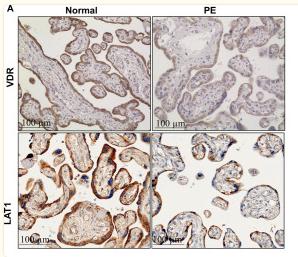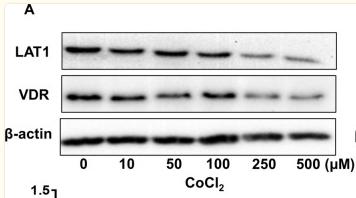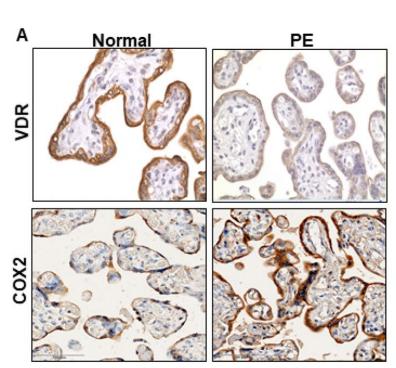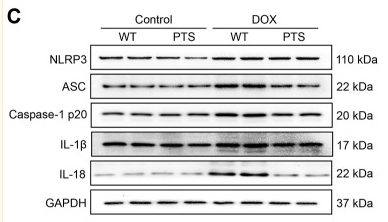Vitamin D Receptor Antibody - #AF6159
| Product: | Vitamin D Receptor Antibody |
| Catalog: | AF6159 |
| Description: | Rabbit polyclonal antibody to Vitamin D Receptor |
| Application: | WB IHC IF/ICC |
| Cited expt.: | WB, IHC |
| Reactivity: | Human, Mouse |
| Prediction: | Pig, Horse, Chicken |
| Mol.Wt.: | 48kDa; 48kD(Calculated). |
| Uniprot: | P11473 |
| RRID: | AB_2835028 |
Product Info
*The optimal dilutions should be determined by the end user. For optimal experimental results, antibody reuse is not recommended.
*Tips:
WB: For western blot detection of denatured protein samples. IHC: For immunohistochemical detection of paraffin sections (IHC-p) or frozen sections (IHC-f) of tissue samples. IF/ICC: For immunofluorescence detection of cell samples. ELISA(peptide): For ELISA detection of antigenic peptide.
Cite Format: Affinity Biosciences Cat# AF6159, RRID:AB_2835028.
Fold/Unfold
1 25 dihydroxyvitamin D3 receptor; 1; 1,25 dihydroxyvitamin D3 receptor; 1,25-@dihydroxyvitamin D3 receptor; 25-dihydroxyvitamin D3 receptor; Member 1; NR1I1; Nuclear receptor subfamily 1 group I member 1; PPP1R163; Protein phosphatase 1, regulatory subunit 163; VDR; VDR_HUMAN; Vitamin D (1,25- dihydroxyvitamin D3) receptor; Vitamin D hormone receptor; Vitamin D nuclear receptor variant 1; Vitamin D receptor; Vitamin D3 receptor;
Immunogens
A synthesized peptide derived from human Vitamin D Receptor, corresponding to a region within the internal amino acids.
- P11473 VDR_HUMAN:
- Protein BLAST With
- NCBI/
- ExPASy/
- Uniprot
MEAMAASTSLPDPGDFDRNVPRICGVCGDRATGFHFNAMTCEGCKGFFRRSMKRKALFTCPFNGDCRITKDNRRHCQACRLKRCVDIGMMKEFILTDEEVQRKREMILKRKEEEALKDSLRPKLSEEQQRIIAILLDAHHKTYDPTYSDFCQFRPPVRVNDGGGSHPSRPNSRHTPSFSGDSSSSCSDHCITSSDMMDSSSFSNLDLSEEDSDDPSVTLELSQLSMLPHLADLVSYSIQKVIGFAKMIPGFRDLTSEDQIVLLKSSAIEVIMLRSNESFTMDDMSWTCGNQDYKYRVSDVTKAGHSLELIEPLIKFQVGLKKLNLHEEEHVLLMAICIVSPDRPGVQDAALIEAIQDRLSNTLQTYIRCRHPPPGSHLLYAKMIQKLADLRSLNEEHSKQYRCLSFQPECSMKLTPLVLEVFGNEIS
Predictions
Score>80(red) has high confidence and is suggested to be used for WB detection. *The prediction model is mainly based on the alignment of immunogen sequences, the results are for reference only, not as the basis of quality assurance.
High(score>80) Medium(80>score>50) Low(score<50) No confidence
Research Backgrounds
Nuclear receptor for calcitriol, the active form of vitamin D3 which mediates the action of this vitamin on cells. Enters the nucleus upon vitamin D3 binding where it forms heterodimers with the retinoid X receptor/RXR. The VDR-RXR heterodimers bind to specific response elements on DNA and activate the transcription of vitamin D3-responsive target genes. Plays a central role in calcium homeostasis (By similarity).
Nucleus. Cytoplasm.
Note: Localizes mainly to the nucleus (PubMed:28698609, PubMed:12145331). Localization to the nucleus is enhanced by vitamin D3.
Composed of three domains: a modulating N-terminal domain, a DNA-binding domain and a C-terminal ligand-binding domain.
The 9aaTAD motif is a transactivation domain present in a large number of yeast and animal transcription factors.
Belongs to the nuclear hormone receptor family. NR1 subfamily.
Research Fields
· Human Diseases > Infectious diseases: Bacterial > Tuberculosis.
· Organismal Systems > Excretory system > Endocrine and other factor-regulated calcium reabsorption.
· Organismal Systems > Digestive system > Mineral absorption.
References
Application: WB Species: Mouse Sample: brain
Application: WB Species: Mouse Sample:
Application: IHC Species: human Sample: placental
Application: IHC Species: Human Sample: trophoblast cells
Application: WB Species: Humna Sample: trophoblast cells
Application: WB Species: human Sample: trophoblast cells
Application: WB Species: Human Sample: CSPCs
Restrictive clause
Affinity Biosciences tests all products strictly. Citations are provided as a resource for additional applications that have not been validated by Affinity Biosciences. Please choose the appropriate format for each application and consult Materials and Methods sections for additional details about the use of any product in these publications.
For Research Use Only.
Not for use in diagnostic or therapeutic procedures. Not for resale. Not for distribution without written consent. Affinity Biosciences will not be held responsible for patent infringement or other violations that may occur with the use of our products. Affinity Biosciences, Affinity Biosciences Logo and all other trademarks are the property of Affinity Biosciences LTD.









